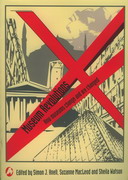review by Paul Ashton

Museum Revolutions has its origins in a major international conference which marked the fortieth anniversary of the department of Museum Studies at the University of Leicester in England. But it is not a conference collection. Rather, as the editors note, Museum Revolutions is a substantial and generally comprehensive text.
Comprising 28 chapters with 31 contributors from countries including Australia, Cameroon, England, France, India, New Zealand, Norway, Portugal, Scotland, Taiwan and the United States, Museum Revolutions is divided into three parts. Part one — 'Shaping museums and manifestos' — primarily addresses 'change and invention'. The 10 chapters that make up this part are about 'manifestos and their implementation' (p. xx). Susan Pearce, for example, explores William Bullock's influence on the invention of a visual language of objects. Philippe Taquet writes about Georges Cuvier's Cabinet d'anatomie comparée in Paris and its sway on future museum practices. And Robert Janes discusses the contemporary museum and social responsibility. Colonial and post-colonial museums are also treated respectively by Sarithri Preetha Nair and Conal McCarthy.
Part two — 'Changing place, changing people' — concerns identity formation and politics and 'sense of place'. Among the nine chapters in this part are Bronwyn Labrum's contribution on community and identity in the construction of Pakeha histories in post World War Two New Zealand; Chia-Li Chen's examination of the shaping of cultural identities in local museums in Taiwan; and Evelyne Tegomoh's reflections on living museums in Africa.
The final part — 'Articulating change: media, message, philosophy' — was devised to look at the 'ways in which museums attempt to investigate change in their publics' (p. xxiv). This part is the least coherent and some of the chapters could easily be placed in other parts of the book. Nonetheless, it contains much stimulating material. Received wisdom, for example, as to audience levels of discomfort and repulsion with controversy is successfully challenged by Fiona Cameron. In her chapter 'Moral lessons and reforming agendas: history museums, science museums, contentious topics and contemporary society', Cameron convincingly concludes that audiences 'want open debate and a range of perspectives'. At they same time, they 'require museums to set moral standards and reforming agendas that can be used to understand and evaluate societal conduct' (p. 340).
In some ways, Museum Revolutions is as much about continuity as it is about change. Ultimately concurring with Margaret Lindauer, whose chapter deals with critical museum pedagogy and exhibition development, the editors recognise:as historians have long done and as this book powerfully illustrates — that museums are constantly in flux, complex and messy. Museums have never conformed to single paradigms and they never will. (p. xxv)On one level, Knell, MacLeod and Watson see fluidity as a positive indicator of healthy evolutions. Flux, however — as they acknowledge — can see the return of undesirable old practices in new guises. The various chapters in the collection which address ethics and museums as advocates or vehicles for social justice indicate the continuation of attitudes or practices in some contexts that require change, radical or otherwise. Reflecting on the field of museum education, for example, Eilean Hooper-Greenhill observes that it is 'trying to establish new paradigms in relation to long-established frameworks' (p. 375).
There are a few lacunas in this collection. Nowhere, for example, is the now well-established field of public history mentioned (one which is emerging rapidly in the United Kingdom). Nor is that of memory studies. Museums figure significantly in the literature of both of these areas of scholarship as do questions concerning cultural authority. Vast communities of museum workers and audiences are also absent. Using the index to locate a discussion of communities or community engagement I found: 'community museums see interpretative centre model' (p. 379).
Museum Revolutions certainly marks, as the editors suggest, a 'new level of maturity' (p. i) in museum studies. But it is also struggling within a larger professional paradigm, revealing a cultural industry that has been slow for various reasons — including that of the role of the state — to open itself up to the winds of change. This, of course, is extremely difficult for any profession to do. But there are various consequences for not doing so. Responding to a national survey in the USA that, among other things, found history museums in the mind of the general public to be highly trustworthy (given their institutional context) and value free, James Gardner of the National Museum of American History, Smithsonian Institution, concluded that this meant that 'the public really don't get what museums do' (Public Historian, vol. 26, no. 4, p. 13).
Museum Revolutions provides insights which will contribute to bridging this gap. I hope that it will reach an audience beyond the tertiary students, academics and practitioners who will benefit significantly from this impressive international collection.
Paul Ashton is co-director, Australian Centre for Public History, at the University of Technology, Sydney.
